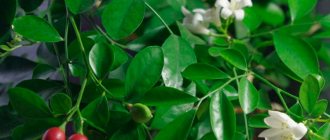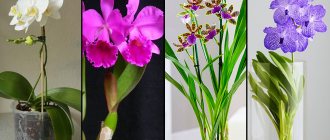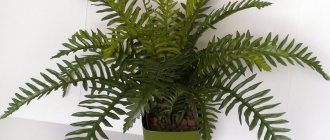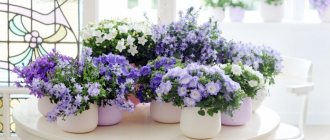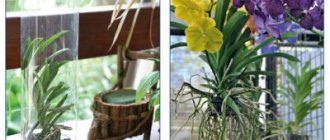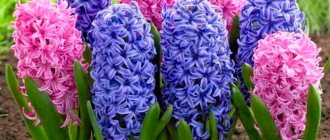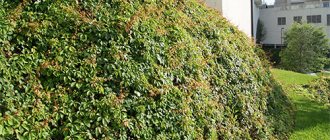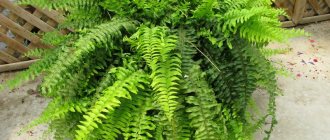Peperomia magnoliafolia is an evergreen, perennial plant of the Pepper family. Native to America and tropical Asia. Prefers loose peat substrate, forest canopies, rock gorges, and tree trunks with rot. Translated from Greek it means “like pepper.” Depending on the variety, it can reach from 15 to 50 cm in height.
Grows as epiphytes and subshrubs. Forms thickened shoots and fleshy leaves. Bisexual, tiny flowers form cylindrical spikelets. But flowering occurs only with short daylight hours. After flowering, red fruits appear. Easily fall off when touched. Let's take a closer look at how to properly care for a decorative flower at home.
Features of home care
The plant is especially popular among gardeners.
In nature, the flower lives in humid and hot forests. Unlike its neighbors, it does not require additional moistening of the substrate. Does not require a pronounced resting stage. Therefore, all care conditions can be observed all year round.
Watering
Leaves and stems can accumulate large amounts of moisture. Drought is not a problem for her. More problems arise from excessive waterlogging. Violation of care recommendations causes rotting of the stems and roots. For watering, use filtered or settled water. Its temperature should be 2 degrees higher than in the room.
In summer, water as the substrate dries. In winter, moisten the soil once a week. You can easily tell when a plant is lacking moisture. The lower leaves will fall off.
Choosing a suitable place
Windows in the western or eastern part of the building are suitable for growing. The plant on the southern windowsill needs darkening. Close the window during periods of intense light (from 11.00 to 14.00) with roller shutters, blinds or regular fabric. Experienced flower growers do not recommend placing flowers on the veranda or balcony in the summer.
Lighting
Provide the plant with bright light. Varieties with bright and variegated leaves especially need such care. Protect vegetative organs from direct sunlight. Dangerous burns may occur.
Pay attention to the color of the leaves. Dark varieties can withstand more darkness. To maintain decorativeness in winter, daylight hours should be extended. Use fluorescent lamps for additional lighting.
The plant can only exist due to artificial lighting. But in this case, you need to use the devices for about 16 hours every day. Please note that plants from garden centers will need time to adjust.
Temperature
Peperomia magnoliafolia will need +22 - +24 °C for full development in spring and summer. In the cold season, the temperature is allowed to drop to +19 °C. At +15 °C the plant may die.
Please note that for growth you also need to control the temperature of the substrate. It should not fall below +17 °C. Avoid sudden changes in temperature, drafts and strong gusts of wind.
Humidity
The plant can develop well at 30% air humidity. But still, the optimal level is on average 60%. You can increase the rate by spraying water. But keep in mind that this procedure can only be carried out on crops without fuzzy leaves.
Experienced gardeners advise placing a container filled with warm water, wet coconut fiber, expanded clay, pebbles or moss next to the flowerpot. A similar effect is exerted by proximity to other representatives of the flora. You can move the flowerpot to the kitchen. The constant evaporation from cooking helps the flower grow. Never add water to the stand. The root system will begin to rot.
You can learn how to care for a plant at home from the video:
Transplant technology
It is better not to disturb the plant again. Crops need to change the substrate and container annually for up to 3 years. Adult plants can be transplanted using the transshipment method in early March. Carry out the procedure once every 3 years. Varieties with small leaves need to be replanted more often.
You can also determine the plant's need for replanting based on several signs. Peperomia magnoliafolia will stop development. There are no signs of damage or disease. The roots have grown through the drainage holes. The soil mixture in the container may also become excessively compacted. This negatively affects the condition of the flower.
The transplant is very easy:
- Fill the third part of the container with expanded clay, pebbles or crushed foam. To disinfect, add a little wood ash.
- Add the prepared soil mixture on top, but no more than 2 cm. Pour water and let it soak.
- Then remove the flower from the pot. To avoid damaging the roots, leave the earthen ball intact.
- Place the peperomia in a new container.
- Fill the remaining space with soil and carefully level it. The ground level should be 1.5 cm below the edge of the container.
- Moisten the soil and place the flower in a warm room with diffused sunlight.
- After 2 weeks, you can transfer the plant to a permanent growing location.
Trimming
To form a flower, you can periodically prune. Use the removed parts for propagation. Try cutting one stem. There should be at least 15 cm left.
Plant the resulting cuttings in a separate container. Over time, side shoots will begin to form from the remaining part. At this stage, you can cut off another shoot. Try to root the apical part. Then plant both crowns in one container. This way you will get another pot with new plants.
To successfully grow a flower, you will not need additional moisture in the environment.
Species diversity
In total, 1161 species are registered in the genus Peperomia. Individual plants can differ greatly from each other. In indoor culture, most often there are no more than 1-2 dozen plants.
Peperomia obtufolia. A subshrub with erect, branched shoots covered with reddish skin, it grows a large number of fleshy, rounded leaves up to 12 cm long. The leaves are single-colored and dark green. They have short petioles. A popular ornamental variety is Peperomia variegata. Its leaves with a dark green center are edged with light green or cream uneven stripes. In the center along the veins, thin strokes are noticeable.
Peperomia obtufolia
Peperomia magnoliafolia. The highly branched, erect shoots have a bare reddish surface and are covered with many smooth, fleshy leaves. The obovate leaf blade with a short petiole grows 12-15 cm in length. Green leaves are sometimes covered with yellow or silvery spots.
Peperomia magnoliafolia
Peperomia Lilian. A compact subshrub with beautiful heart-shaped leaves is highly decorative. The surface of the leaf blade between the veins is swollen and may have a contrasting color. The shiny, fleshy leaves grow close together to form a dense bush. At the beginning of summer, dense inflorescences with a thickening at the end appear. They rise above the green mass on long peduncles. The greenish-white or cream inflorescences vaguely resemble lily buds, which is how the species got its name.
Peperomia Lilian
Peperomia clusifolia. The large subshrub is distinguished by erect, fleshy shoots. They bear large, short-petiolate, obovate-shaped leaves. The length of the thick leaves reaches 15 cm. They are dark green in color and have reddish-brown streaks closer to the edge.
Peperomia clusifolia
Peperomia Rosso. The subshrub up to 25 cm high is covered with fleshy leaves. On succulent stems, foliage grows in bunches, close to each other. The plant is famous for its high decorative value due to the spectacular coloring of the leaves. Their surface is painted in a uniform dark green shade. The reverse side has a bright red-burgundy color. In indoor conditions, the variety almost does not bloom.
Peperomia Rosso
Peperomia whorled. The herbaceous perennial is suitable for hanging. Its lodging long stems are covered with medium-sized, fleshy foliage of oval or rhombic shape. Green leaves, practically without petioles, grow in whorls at the nodes. Flowering occurs in June.
Peperomia whorled
Peperomia pereskifolia. The large variety has highly branched shoots. At the beginning of growth, the stems grow straight, but gradually lower under their own weight. The foliage is grouped into whorls of 3-5 pieces. Oval leaves with a blunt edge grow 3-5 cm in length and 2-3 cm in width. Arched veins are visible on the leaf surface. Dark green foliage is covered with pinkish or silvery streaks.
Peperomia pereskifolia
Peperomia capita. The ampelous species grows long, but thin, creeping shoots. They have wide oval, small, bright green leaves.
Peperomia capita
Outdoor breeding
The plant cannot easily withstand hypothermia. For example, during transplantation the temperature should not be allowed below +17°C. Also, the flower may suffer on a cold windowsill. You will have to change the planting location or place a sheet of foam under the flowerpot.
Due to this increased sensitivity, peperomia magnoliafolia cannot be grown in an open area. There are several varieties that can be kept outdoors in a container in the summer. But in this case, it is necessary to create favorable conditions.
Botanical description
Among plants, it is classified as an epiphyte from tropical and subtropical regions of South America. Belongs to the family of peppery, perennial, herbaceous plants. In size there are representatives from 14 centimeters in height to half a meter.
Reference! The name “peperomia” itself is translated from Greek as “pepper-like”.
Variegated peperomia or Peperomia Variegata is represented by three varieties:
- blunt-leaved (Obtusifolia Variegata);
- magnolia (Magnoliaefolia Variegata);
- clusiifolia Variegata.
Peperomia Variegata does not occur in nature; it is the result of pure selection.
Container growing technology
soil mixture
For breeding at home, experts recommend using a substrate that perfectly allows moisture and air to pass through. Let's consider the best options for soil mixture:
- Universal soil for succulents. You can prepare the mixture yourself from peat, leaf humus and coarse river sand.
- Soil for ficus or palm trees is also suitable. You must add vermiculite or perlite to it.
- Humus, garden soil, moss, coconut fiber (crushed), fine expanded clay (no more than 3 mm).
You can avoid all soil problems if you use hydroponics for cultivation. You can also create an elegant composition with the help of a plant. Moss or driftwood is suitable for this.
Top dressing
Experienced gardeners recommend using complex fertilizers in liquid form for peperomia magnolia leaf. They can be purchased at any store. For processing, you need to reduce the dosage specified in the instructions by half.
Container options
Wide, low dishes are suitable for growing flowers. With each transplant, increase the diameter of the container by one and a half times. Don't use a large flowerpot. Unfortunately, peperomia develops very slowly. Therefore, all the energy will be spent on growing the root system.
Similar flowers
The following plants are similar to Peperomia magnolia:
- Ficus. It has a well-branched root system, dense leaves of bright green color.
- Boxwood. This is a shrub whose height is 2-12 m. The leaves are similar to peperomia, which have a dark green color and a glossy surface.
- Jade tree. It features interesting twisted branches and fleshy leaves.
- Anthurium. This is a glossy flower that resembles an artificial plastic plant in its color and appearance.
- Pisonia umbellata. The leaves are large, opposite, dark green. Their length is 25 cm, width is 10 cm.
Peperomia magnofolia is an interesting plant that is valued by gardeners for its foliage. It has a glossy surface, and spots and stripes of light or dark green color may be scattered across its surface. The ease of caring for the crop allows even a beginner to grow it.
Characteristic problems and diseases
In a room with dry air, spider mites may appear on peperomia. Determining a pest settlement is quite simple. A web appears on the stem (usually in the internode). The leaves wither and fall off.
You can get rid of tiny insects using a soap solution. Then you need to shower with warm water. Spray the plant with water periodically. Severely affected peperomia should be treated with Actellik. For 1 liter of water you will need 2 ml of product. A 0.15% solution is suitable.
Thrips prefer rooms with high temperatures and low humidity. The operation of heating appliances especially contributes to such conditions. The pest primarily attacks the lower part of the leaf. You will notice light spots on the top plate. Eventually the leaf on top will turn brownish-gray with a silvery tint. It is quite difficult to detect the parasite after settling on variegated varieties. You can get rid of the insect by spraying with insecticides.
The plant may also suffer from mealybugs. The pest will die after treating the leaves with alcohol. Use a regular cotton pad for cleansing.
Fungal infections can cause root and root collar rot. They occur as a result of waterlogging or soil compaction. At the initial stage, you can save the flower. To do this, reduce the number of waterings; if this does not help, replant the plant.
There are known cases of peperomia infection with a virus that causes dwarfism. It is necessary to immediately destroy the plant along with the soil and container. Otherwise, other crops may suffer.
How to trim peperomia
Only large varieties need pruning. It is used to increase bushiness and give the plant a beautiful shape. Pruning is quite simple: inspect the bush, and then use garden shears to carefully pinch off weak shoots from the top. Thanks to this procedure, the plant will acquire a magnificent appearance. If you do not want the bush to waste energy on flowering, cut off the developing inflorescences. As for compact species, they are pruned only to remove wilted, damaged or dry leaves. Note that young peperomia respond better to this procedure.
Flowering and beneficial properties
It is recommended to keep Peperomia magnolia folia in the bedroom or living room. The plant promotes a friendly atmosphere in the home. According to experts, the culture supports the energy field of the room with its variegated color, bushy shape and numerous leaves. Negative emotions are smoothed out.
The plant is able to delight and warm its owners. In addition, cultivation improves health. Positively affects the condition of the mammary glands, gall bladder, and gastrointestinal tract.
A small plant can be placed on your desktop.
Releases phytoncides. The component purifies the air from harmful microorganisms. Therefore, it is recommended to keep the plant in the children's room. Especially if the child is often sick.
Reproduction technique
It is very easy to spread peperomia at home. Even a novice florist can handle it. You can find planting material in almost any gardening office or specialized online store. Let us examine in more detail the methods of flower propagation.
Peperomia magnoliafolia from seeds
It is not necessary to buy rudiments in the store. Seed material can also ripen at home. Collect the seeds in bags (preferably using paper). Store in a dry place, away from direct sunlight until the end of April. Then start planting:
- Prepare a flat, shallow dish. Fill it with substrate. A mixture of universal purchased soil for indoor ornamental plants and coarse river sand is suitable.
- Moisten the soil.
- Scatter the seeds on the surface of the substrate.
- Cover the top with a thin layer of soil (no more than 2 mm).
- Spray warm water from a spray bottle. Cover the top with a plastic bag or glass for a greenhouse effect.
- Provide optimal conditions. The rudiments will need bright lighting and an air temperature ranging from +24 to +27 °C. You can also organize bottom heating. A regular heating pad will do. Open the greenhouse every day for fresh air. This will prevent condensation and rotting.
- Do not allow the substrate to dry out. Spray it regularly, as needed.
- When the sprouts have 2 full leaves, transplant them into separate containers. As a substrate, use a mixture of universal soil, peat, fertile soil and clean sand.
- With proper care, about 6 leaves will form in six months. At this stage, you can dive them into pots. The average diameter of the container should be 8 cm. Further care is no different from adult plants.
Cuttings
For propagation, use the upper part of the shoot. The middle part of the stem will also work. Just clean it of leaves first. Please note that the success of the procedure depends on the number of nodules. Each cutting must have at least two growth points. As a rule, about 80% of planted shoots take root.
Experienced gardeners also propagate peperomia by leaf. But for this you will need an adult plant over 3 years old. The crop should not show damage or other signs of disease. Shorten the petiole to a minimum.
The procedure includes several stages:
- At the end of October, cut the cuttings. Use a sharp, sanitized knife.
- Place the shoot in a container with a root stimulator. You can also disinfect planting material with a weak solution of potassium permanganate. 3 hours of processing is enough.
- Apply activated carbon or crushed chalk to the affected area. Leave to dry for an average of 24 hours.
- Several substances are suitable for rooting - sand, water, peat, vermiculite or moss. Please note that the cuttings from the apical part must be inserted into the substrate with the cut side down. It is better to place stem planting material horizontally.
- Cover the top with a plastic bottle (cut) or glass jar. Maintain the ambient temperature between +25 and +27 °C.
- Do not allow the substrate to dry out.
- Under favorable conditions, roots will form in an average of 3 weeks. Let them get stronger and transplant the cuttings into a standard peperomia substrate.
With the help of cuttings, you are guaranteed to preserve the varietal characteristics of the plant.
Dividing the bush
It is advisable to carry out the procedure during spring transplantation. Divide a large peperomia bush into several parts. The procedure is no different from those described above. Use a clean, sharp knife to separate. You can prevent rotting using activated carbon. Treat the cut area with it.
Transplanting a plant
If the plant was purchased in a store, you should look to see if the roots are peeking out of the drainage holes. If they are not there, it is too early to replant. If deformed roots are found on the bottom of the pot, the flower must be urgently replanted.
The need for replanting in home peperomia is revealed by deterioration in appearance: shredding of leaves, thinning of shoots. Perhaps the plant is thickened, the pot has become cramped, and the roots are looking for a way out, penetrating into all the drainage holes.
The most favorable time for transplantation is spring. In winter, plants are replanted only if absolutely necessary (for example, due to illness).
Note! For each subsequent transplant, it is necessary to select a pot 3 cm (in diameter) larger than the previous one.
A layer of drainage (4-6 cm) is placed at the bottom of the pot (necessarily with drainage holes): medium-sized stones, charcoal, dry moss. The soil used is either store-bought soil suitable for this category of flowers, or homemade soil - from equal parts of turf, ordinary garden soil and humus, with the addition of sand and peat. The last 2 components take ½ part each.
Choosing planting material
Peperomia magnolia folia in a container 35 cm high and 14 cm in diameter can be purchased for 1,658 rubles. In garden centers you can often find peperomia "Lillian" and peperomia cluzifolia. Be sure to pay attention to the absence of pests. Examine the flower.
A characteristic white coating resembling powder or brown scales indicates damage to the crop. Never purchase peperomia with drooping leaves. Especially if the container contains a wet substrate. This may be a sign of rotting root system.
For garden cultivation, you can buy one of the forms of the crop - Variegata. It is distinguished by a special structure of vegetative organs and yellow-white spots. For outdoor cultivation, special conditions must be created. Follow the basic rules of care, and the plant will become a real decoration of your home.
Varieties
Experts identify quite a few types of peperomia. Among them there are also quite popular ones, which are in greatest demand among lovers of indoor plants.
One of them is Peperomia obtufolia. This flower is a perennial. Interestingly, this plant can grow not only on the ground, but also on trees. Its leaves are fleshy and dense to the touch. Their sizes are usually 3-6 cm wide and 9-11 cm long. The surface is corrugated, and the color of the leaves can be different - dark green, cream or white.
It is recommended to place such a plant in fairly bright rooms, closer to a natural light source.
Experts in caring for indoor plants recommend that when purchasing, be sure to pay attention to a specific type. Quite popular species include: “Green Gold”, “Ferreira”, “Tupolistnaya”, “Variegatnaya”, “Glabella”, “Whorled”, as well as various mix varieties

